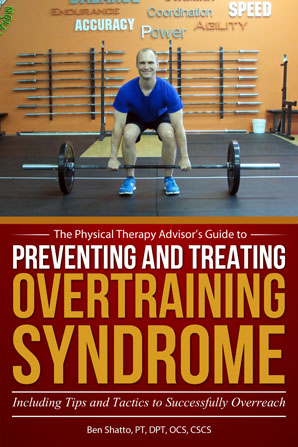New Year…New You! With the beginning of a new year comes the drive to want to do something different and better than the previous year. Resolutions, new changes, new outlooks, and new workout routines are on the top of many people’s resolution list for the new year.
Getting in shape is important for your physical and mental health, but as with everything, you can do too much. As we get into our new routines with fresh motivation, we push ourselves harder–we run faster, swim further, and lift more. Yet while our new workouts may seem outwardly healthy, we may actually be doing ourselves harm in the long run.

Why? For some of us, the exercise routines we have been inspired to take on have turned from ‘healthy’ to ‘unbalanced’. It may be that we progressed too fast or our volume or intensity of training is too high for our present conditioning.
More commonly, there was not enough attention put into the recovery portion of training. In other words, as we’ve pushed ourselves on the court, in the pool or on the bike, we’ve lost track of our personal limits. We’ve fallen prey to what is generally called Overuse Training Syndrome (OTS). It’s also referred to as Overtraining Syndrome.
Overuse Training Syndrome is pretty much exactly what it sounds like: it occurs when the body is pushed too far during exercise and/or training–over and above its limits for too long–thereby causing it to lose its ability to recover in a sustainable and safe way. For obvious reasons, this wreaks havoc on both your health and your training routine, not to mention to your mental endurance. The training cycle should consist of a balance of training, recovery, and then adaptation. Too much training and not enough recovery means no adaptation and in the case of OTS, a regression of health and training status.
Overtraining typically leads to worsening performance and results. Unfortunately, the most common reaction to OTS is an even greater commitment to training harder, faster, and more often. The effects typically end in disaster.
Overuse Training Syndrome (OTS) Symptoms:
- OTS makes you tired–not in the traditional ‘good workout sense’, but fatigued in a way that throws your training and muscle wellness off balance. This type of exhaustion is often confused with a sense of demotivation or laziness, thus leading many people to push-through and push harder. Sadly, this approach does a lot more harm than good as it delays recovery for longer periods which places even more stress on your overall health, stamina, fitness, and body. This is typically due to over fatigue in either the sympathetic or parasympathetic nervous system depending on your most common form of exercise/training.
- OTS feels a little like the flu: a dull aching in your muscles and joints, lightheadedness during exercise, slight nausea, and overall grumpiness follows its onset. In general, OTS leads to the lessening of enjoyment during exercise as your goals aren’t met and your motivation declines. OTS is thus mentally and physically debilitating. Yet apart from fatigue and an overall dampening to your exercise routine, OTS and its resultant drive to push harder and faster may actually lead to a number of serious and harmful consequences.
- Exercising too much and pushing certain areas of your body to the brink and beyond often leads to disturbances which may cause short and long term damage. Examples of these types of injuries include: tendinitis; carpal tunnel syndrome; plantar fasciitis; and patellofemoral pain. Indeed, if the names don’t scare you away, then the pain associated with these conditions will.
- Perhaps more common when it comes to OTS are symptoms you may in fact already be experiencing. These include insomnia, elevated heart rate, appetite loss, decreasing muscle mass, dwindling performance, and muscle soreness. None of these symptoms are particularly enjoyable. While you may think that exercise may actually alleviate the symptoms, the truth is that increased activity will only worsen them exponentially.
So, what can you do? You love training, your routine is magnificent, and you’ve finally mastered the art of waking up early enough to get the right amount of activity in before work. How could you possibly change anything at this point?
It’s time to start being very honest with yourself. Exercise is wonderful for you, but too much of it may actually be putting you at a disadvantage. The key is–as with so much in life–balance. It’s very important to balance the duration, type, and pace of your routines in order to make sure that no one part of your body is constantly under fire.
Although it may be difficult to accept at first, rest is just as important as exercise. It’s absolutely crucial that you give your body time off to recover and rest. This will allow your muscles to repair themselves, your joints to heal, and your endurance to be prolonged. The training cycle should consist of the right balance of training, recovery, and then adaptation.
Working out is as much about the ability to listen to your body as it is to push it to be its best. Adding a rest day (or two) to your week will actually be more beneficial to your workout than skipping them. As an extra bonus, you can sleep a bit later on those days! Balancing exercise and rest is the most effective way of staving off the risks associated with Overuse Training Syndrome. Knowing how to do this is, however, tricky for many of us.
For more information on overtraining, be sure to check out my 12 Tips to Prevent Overtraining Syndrome and 10 Tips to Self-Treat Overtraining Syndrome. In addition, you can find more recovery tips in Muscle Cramping & Spasms – Treatment Options.
If you are interested in a more thorough look at Overtraining Syndrome and how to use overreaching as an effective training tool, be sure to check out my book on Amazon, Preventing and Treating Overtraining Syndrome. I show you how to recognize the risk factors and symptoms of OTS. You’ll learn how to utilize prevention strategies to help you develop a personal training strategy that will allow you to push past your limits and prior plateau points in order to reach a state of what is known as overreaching (your body’s ability to “supercompensate”). This will speed up your results, so that you can train harder and more effectively than ever before! In addition, learn how to use the foam roller (complete with photos and detailed exercise descriptions) as part of a health optimization program, recovery program, rest day or treatment modality.
Nothing can derail your best laid training plans and goals like an injury or suffering from OTS! If you develop OTS, you will need to take specific steps to speed up your recovery in order to prevent injury and return to a normal training schedule. Be sure to check out my book today in either paperback or on Kindle!

